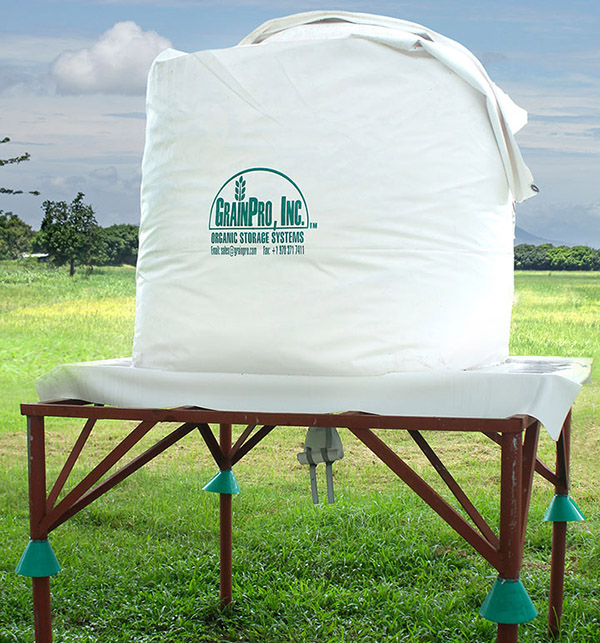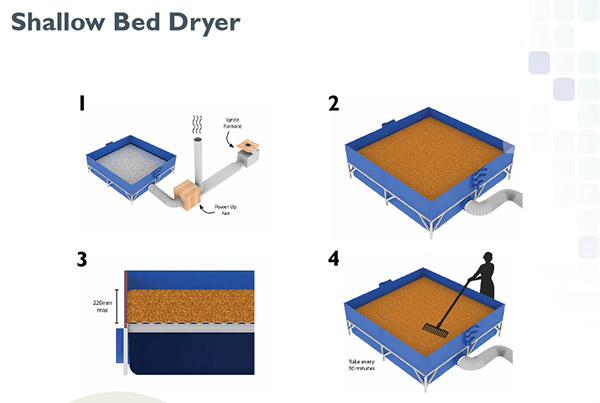 14 August 2015. Agrilinks interviewed Sophie Walker, Chief of Party of AflaSTOP project.
14 August 2015. Agrilinks interviewed Sophie Walker, Chief of Party of AflaSTOP project.Based in Kenya, AflaSTOP is investigating storage devices that will prevent the growth of aflatoxin-producing mold during storage and exploring drying technologies that will help farmers reduce grain moisture from current levels at 15-18 percent to a safer 13.5 percent.
AflaSTOP intends to commercialize the most promising of these technologies in order to scale adoption.
"The goal of my work right now is mass adoption of these storage and drying devices by smallholder farmers, either as an investment on farm or a service that they buy in to. We need to ask ourselves how we can provide the knowledge to private sector companies working in this area so they can drive their supply chains down to small agridealers."The AflaSTOP: Storage and Drying for Aflatoxin Prevention (AflaSTOP) project is identifying the most promising storage options to arrest the growth of aflatoxin and designing viable drying options that will allow smallholder farmers to dry their grain to safe storage levels.
 |
|
into the country duty free. Current storage
capacity ranges from 800-1,300 kg.
They will soon be introducing a 500kg bag.
The estimated cost for the frame and bulk bag is around $260.
|
The project works to ensure that businesses operating in Africa are able to provide these devices to smallholder farmers.
Linking scientifically rigorous research with human-centric design and grounded in marketplace realities, the project consists of three core components:
Linking scientifically rigorous research with human-centric design and grounded in marketplace realities, the project consists of three core components:
- Storage: scientific testing of storage devices in controlled conditions and field testing with smallholder farmers
- Drying: research, design, testing, fabrication, and adaptation of potential drying solutions
- Commercialization strategy development: tailored investigation and validation of the commercial viability of each storage and drying product
 |
Metal Silo: The silos are made out of aluminum
and produced by local artisans. They are placed
on a pallet and size ranges from 200-1,000kg.
Estimated cost is $144.
|
As for drying technology, the shallow bed dryer shows the most promise. It is a completely new device that has never gone to market. The basic configuration of this mechanical dryer is a furnace, a heat exchanger and a supply of air (provided by fan). The heat from the furnace moves through the heat exchanger and through the raised bed that contains the grain.
AflaSTOP supports the objectives of the Partnership for Aflatoxin Control in Africa (PACA), which is establishing a comprehensive, Africa-wide approach to aflatoxin control. Cofunding for this project is provided by the Bill & Melinda Gates Foundation and USAID, and the project is jointly implemented by ACDI/VOCA and Agribusiness Systems International (ASI), under the direction of Meridian Institute.
Resources:
27 July 2015. Mycotoxin Detection OptionsAflaSTOP supports the objectives of the Partnership for Aflatoxin Control in Africa (PACA), which is establishing a comprehensive, Africa-wide approach to aflatoxin control. Cofunding for this project is provided by the Bill & Melinda Gates Foundation and USAID, and the project is jointly implemented by ACDI/VOCA and Agribusiness Systems International (ASI), under the direction of Meridian Institute.
Resources:
- Kenya - AflaSTOP 2014 Annual Report (PDF, 752 KB)
- Summary of Drying Technologies (PDF, 482 KB)
- Storage and Drying Survey North Rift (PDF, 1310 KB)
- Storage Surveys in Kenya: North Rift and Eastern (PDF, 782 KB)
- AflaSTOP: Summary of Storage Devices under Testing (PDF, 381 KB)
- Poster: AflaSTOP: Storage and Drying for Aflatoxin Prevention (PDF, 1 MB)
- Findings from On-Farm Acquisition of Maize Contaminated with Aflatoxin (PDF, 816 KB)
We would like to see standardized testing protocols across all of Peanut & Mycotoxin Innovation Lab (PMIL’s) programs and develop an information Booklet and Web-based recommendation app.Kumar Mallikarjunan is a Professor at Virginia Polytechnic Institute and State University in Blacksburg, VA. He has been involved with the USAID funded peanut projects for almost 20 years – formerly with the Peanut CRSP and now with the Peanut and Mycotoxin Innovation Lab.
27 July 2015. Solar Drying to Control Aflatoxin Contamination in Peanut
Aflatoxin is not something that is well known outside the scientific community. Most families in Ghana do not know much about it. Actually, I hardly hear anything about it in Ghana. Solar drying does not expose the peanuts directly to sunlight and they are not exposed to rain either. The dryer has a collector to capture the heat from the sun and an enclosed structure around the nuts that conducts the heat. Everything is enclosed so there will be no moisture from rain. I want to work to create technology that eliminates aflatoxin and that is affordable and easily transferred to farmers.Maxwell Lamptey is participating in a short-term training program supported by the Peanut and Mycotoxin Innovation Lab from March to September 2015. He is a senior technical officer working on legumes at the Crops Research Institute (CRI) in Kumasi, Ghana.





No comments:
Post a Comment